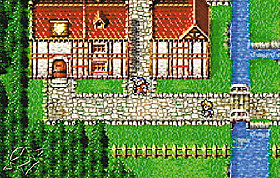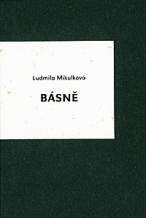| Zeitschrift Umělec 2001/4 >> Spinning Blades | Übersicht aller Ausgaben | ||||||||||||
|
|||||||||||||
Spinning BladesZeitschrift Umělec 2001/401.04.2001 Jeffrey Bartel | focus | en cs |
|||||||||||||
|
I’m standing at a bar, glass of Miller Lite in hand, with a group of people from work. As with any gathering of people from a workplace, the bitching is fast and furious. In the background, a couple karaokes “Summer Dreams.”
“So I’m going to write an article about video games,” I say. “For Umělec, an art magazine out of Prague.” After the cheers and backslapping subside, I continue: “So what’s your reaction to video games? What do you think of them?” “Waste of time.” “Expensive waste of time.” “They’re ok for kids.” “Yeah,” chimes in another, “there’s some good educational software for kids. Where they can learn to spell, or work with numbers.” “I played a lot of video games in college. It was fun, but I wasted a lot of time.” “Ok,” I say. “So can you think of any good things about video games?” “They can be really fun.” “Yeah, but God, they can be so violent — I saw this one commercial, it was saying, ‘Hit your opponents with other opponents!’ and it had this guy running around hitting guys with this torso.” “I’ve got to stay away from them. I get way too addicted.” “Yeah.” Every generation of children faces an unexplored frontier: The kids before me staked out television. For my generation, the frontier could be found in converted warehouses filled with consoles of Dig-Dug and Tempest, in pizza parlors, and especially in basements: an Atari 2600 or Intellevision hooked up to an old TV — tangles of cables and scattered cartridges of Defender and Pitfall, blocky shapes on the screen jumping over or shooting other blocky shapes on the screen. Pong was the progenitor. Before Mario started jumping barrels, before Pac-man started chewing electric speed, before Space Invaders, um, invaded ... Pong appeared, introducing the world to the concept of the video game. A block of light, bouncing back and forth between two thin rectangles, one or two players manipulating a dial in an attempt to score. Games have come an immense distance since those days: using a character like Lara Croft or Mario (still plagued by simians, still engaged in what’s coming off as a fruitless quest for a princess) as an avatar, one can now explore massive environments, filled with detail and imagination. The sound has evolved from having roughly the personality of a dialing telephone to almost film soundtrack quality, complete with musical score, ambient noise, and footsteps that echo both realistically and ominously. But the essence remains the same: using a keyboard, mouse, or joystick to manipulate an image on a screen. And the question presents itself: Is this a worthwhile way to spend time? The recently released Sony Playstation 2 sold like electric hotcakes, and coming soon are Microsoft X-Box and the Nintendo Game Cube, promising faster action, more fluid gameplay, more realistic flying corpses. Gameboys proliferate. PC games allow players to link up over the Internet, so that people from all corners of the world can interact in labyrinthine RPGs, race one another, and of course blow each other up. My generation may think of games as an expensive waste of time, but that isn’t stopping us from pulling out our wallets and hitting the continue button. As I said, every generation is assigned a frontier, but my generation, Gen X slackers all of us, fucked up the assignment. We explored: Hours were spent on research, and many of us are better versed in Q*bert than politics. We are, every one of us, trying in one way or another to build a better world, better lives. But what can be the good in making tiny phosphorescent dots move around? Video games sure won’t curb the growing obesity of the populace — quite the opposite. They won’t teach us to love more purely, confront injustice more effectively, face our own faults more honestly. So what good are they? We never answered the question. We called video games a waste of time, and too addictive, and played them until adult responsibilities forced most of us to hand the controller to our children. And so, as I face the question, as I search for merit in the land of power-ups and unreachable high scores, I begin my journey with an empty inventory and no instructions on how to win this one. By way of qualifications, I’m the world’s greatest living player of Miner 2049er. I didn’t win any competitions to gain this distinction, nor am I willing to take on challengers. But it’s my game. I’m the world’s greatest living player of an obscure simple platform game from 1983 because it was the only cartridge game I had for the Commodore 64, that bastion of personal computing in the mid-1980s. The C64 had two ways of accessing games: cartridges or floppy disks, in all their 5.25” glory. Loading a game from a floppy disk took anywhere from one to five minutes. Car-tridges loaded instantly. The relationship of people to their computers has changed with the advent of the Internet, of course, but it was also revolutionized by the arrival of home computers that could actually do much of anything. I used the C64 from the age of 11 all the way through college, mostly as a word processor — a painfully unwieldy word processor, but still preferable to a typewriter. (For those considering the use of the C64 as a word processor, note that it was impossible to read an entire line of text at once: only two thirds of the width of a page could be displayed, making for furious work with the cursor to get any reading done at all. Also, reading for any extended period of time off of a television screen produces blazing headaches. And the only printer you can hook up to a C64 is a dot matrix, these days only good for throwing against a wall.) So, from age 11 through college, I’d occasionally pop in Miner 2049er, and play for a bit. And I grew amazingly proficient at the game: Playing became automatic, not requiring any higher brain activity at all. And like a priest with his rosary, a Buddhist with his mantra, I achieved trancelike states of calm as a crudely rendered miner evaded cave monsters. Addiction: To surrender (oneself) habitually or compulsively to something. Webster’s II New Riverside Dictionary. You walk hesitantly into a large valley, bordered on both sides by cliffs. Ferns underneath, what appears to be the remains of a broken rope bridge overhead. Metal scrapes against leather as you pull your guns out of their holsters, because it’s QUIET, TOO QUIET! and sure enough something emerges from the darkness ahead, pausing only to let out a familiar roar before running at you full-tilt, grabbing you in its enormous jaws, and killing you with a decisive snap. The T-Rex sequence in Tomb Raider: That’s where I lost it. Before that moment, video games (Miner 2049er to the contrary) didn’t have that much of a grip on me. But my roommate in college had the Sega Saturn, and he bought Tomb Raider when it first came out. The game struck me as a mixture of interesting and irritating: 3D movement was still unfamiliar in 1996, and I constantly walked into walls and fell off cliffs, unsure about this new type of game. And the graphics were heavily pixilated, to the point that it was often hard to tell floor from wall. But once that giant sumbitch stormed out of nowhere ... the game had me, and years later, it still hasn’t let go. I can’t talk with authority about first-person shooters (i.e. Doom and its numerous progeny: Half-Life, etc), nor about fighting games, sports games, RPGs, flight simulators, SIMs, survival horror (although a friend and I cheated our way through Resident Evil in a week) or the thousand other varieties of games that have people glued to their monitors or TVs. I’m just addicted to Tomb Raider, and I can talk about it. I can talk about Tomb Raider. “A book that’s only worth reading once isn’t worth reading at all.” C.S. Lewis For this article, I bought the first TR for my computer. I could have bought TR: Chronicles, the latest in the series, but I was scared: I knew I’d spend too much time playing the game, mentally justifying it as “research.” But to write accurately about video games, you should have the experience of them fresh in your mind, right? So I’d sit down to work on the article, but first I’d pop in the game, just to play a little, just to get in the right frame of mind. Just to get past that level with the trick jumps over the high columns. Just to get to the next switch, or idol, or door. Just to kill that lousy panther pack. Just to spend too much time playing TR over again and justifying it as research. It’s an ugly truth, but a truth known to anyone with access to video games: Sometimes, it’s a lot easier to let an assignment slide (or a phone call, or an apartment really in need of cleaning), just in order to manipulate a video automaton through a series of precise jumps over lava. In the time it’s taken me to write this article, I played through the entirety of Tomb Raider again. So was it a game only worth playing once, and therefore unworthy of any consideration? To be sure, the rapid improvements in subsequent games have left many aspects of TR seeming antiquated, and the chunky, pixilated graphics induce tears after a few minutes of play. That said, what made TR great when it came out, and what has made the subsequent games so much fun to play, remains. Here, a movie cliche: “So you see, my friend, that every room in this house is boobytrapped with a fiendish and deadly surprise — come and get me, if you dare!” That’s Tomb Raider: you pit your skills against the malicious game designers who have you sliding towards spikes coming up from the floor while a boulder crashes down at you from behind, and overhead a pendulum slices across your path. Malicious bastards who often foresee your first instinct, and make you pay for your obviousness with death. Tomb Raider fascinates because it engages the part of the mind that demands an answer to a puzzle, that wants to work things out. And, if you put in the time, and think, you get to advance, and move on, and discover. That’s how games are similar to, and dissimilar to, life. I called my friend, Chris, who knows games, plays them, enjoys them. “Are there any redeeming features in playing video games?” “Hand-eye coordination.” He’s joking, of course. Everybody says “hand-eye coordination.” “Beyond that.” “Maybe good for problem-solving skills, or as stress relief. Other-wise, playing video games is about as useful as watching TV.” “Yeah, but there’s some really good—” “About as useful as watching an episode of Friends.” “But some of the games are getting really sophisticated, surely there’s—” “Let’s put it this way: video games haven’t produced anything on the level of, say, Schindler’s List.” “Alright, but look at it like this: Pong basically hit the market around 1972, Space Invaders was released in about 1978. OK, so depending on how you want to look at it, video games are around 25, 30 years old. Now, the first Lumiere films came out in 1895. Twenty-five, thirty years later, you’re still in silent film — you’ve got Metropolis, you’ve got Nosferatu. But you don’t have sound. So maybe that’s video games.” “Yeah, maybe.” Computers. I’m facing the monitor of my computer as I type this, or as I balance my checkbook at the end of the month, or as I download music, a jpeg, read the latest issue of the Onion. My 17” monitor frames my finances, my correspondences, my secrets. At work too: Program after program crunches dates, numbers and words, creating some kind of order, creating movement and activity, as we shape the present and the future by the application of fingertips to keys, the small circles of a mouse against a corporate mousepad. Computers can be hell! The damn things crash, they freeze, they eat away at your time as when for obscure reasons a vital file that was just there, isn’t anymore. They burn your eyeballs and put an ache in your lower back. And that’s when there isn’t anything in particular wrong with them, never mind when things go bad. And while we are getting accustomed to them, these typewriters hooked up to TVs hooked up to miles of wire intestines ... there’s still uncertainty. We don’t quite know what they’re capable of yet. The paranoid silliness of War Games and Terminator has evolved into the more elaborate paranoid silliness of the Borg and the Matrix, but somewhere in our heart of hearts, something whispers, “These damn things will kill you. They’ll take away your humanity. They’ll devour your soul.” But of course, that’s true of all of the best and worst things in life. The ending of Tomb Raider, as with all of the TR games, is anticlimactic. An island blows up, and “The End” flashes across the screen. The popularity of the games led to the release of a movie. In Lara Croft: Tomb Raider Angelina Jolie looks crazed enough to spend a lot of time making dizzying jumps and blowing away animated statuary, but beyond her demented beauty, the movie disappointed me. I’d hoped for the chessmaster mindset of the game, always a few jumps ahead. Ultimately, playing Tomb Raider leaves me with a higher opinion of humanity than watching the movie did. Score one for video games. So are video games worth time in your life? One last thought to consider: An increasing amount of our time is spent in front of computers these days in the workplace, in schools, in trendy coffeeshops, and at home. That monitor can contain practically anything we want it to, can provide answers to questions we’re only just beginning to formulate. As we consider the possibilities down the road, surely having fun must be a factor in the equation. I’m not too worried about exploring computers, though. I figure that’s the frontier for the next generation. But I do encourage the kids to play.
01.04.2001
Empfohlene Artikel
|
|||||||||||||
|
04.02.2020 10:17
Letošní 50. ročník Art Basel přilákal celkem 93 000 návštěvníků a sběratelů z 80 zemí světa. 290 prémiových galerií představilo umělecká díla od počátku 20. století až po současnost. Hlavní sektor přehlídky, tradičně v prvním patře výstavního prostoru, představil 232 předních galerií z celého světa nabízející umění nejvyšší kvality. Veletrh ukázal vzestupný trend prodeje prostřednictvím galerií jak soukromým sbírkám, tak i institucím. Kromě hlavního veletrhu stály za návštěvu i ty přidružené: Volta, Liste a Photo Basel, k tomu doprovodné programy a výstavy v místních institucích, které kvalitou daleko přesahují hranice města tj. Kunsthalle Basel, Kunstmuseum, Tinguely muzeum nebo Fondation Beyeler.
|


































 Potsdamer Str. 161 | Neu Divus in Zwitschermaschine, galerie und buchhandlug in Berlin! | Mit U2 nach Bülowstraße
Potsdamer Str. 161 | Neu Divus in Zwitschermaschine, galerie und buchhandlug in Berlin! | Mit U2 nach Bülowstraße
Kommentar
Der Artikel ist bisher nicht kommentiert wordenNeuen Kommentar einfügen